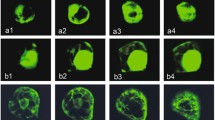Abstract
In grass cell walls, ferulic acid esters linked to arabinosyl residues in arabinoxylans play a key role in crosslinking hemicellulose. Although such crosslinks have a number of important roles in the cell wall, they also hinder the rate and extent of cell wall degradation by ruminant microbes and by fungal glycohydrolyase enzymes. Ferulic acid esterase (FAE) can release both monomeric and dimeric ferulic acids from arabinoxylans making the cell wall more susceptible to further enzymatic attack. Transgenic plants of Lolium multiflorum expressing a ferulic acid esterase gene from Aspergillus niger, targeted to the vacuole under a constitutive rice actin promoter, have been produced following microprojectile bombardment of embryogenic cell cultures. The level of FAE activity was found to vary with leaf age and was highest in young leaves. FAE expression resulted in the release of monomeric and dimeric ferulic acids from cell walls on cell death and this was enhanced severalfold by the addition of exogenous β-1,4-endoxylanase. We also show that a number of plants expressing FAE had reduced levels of cell wall esterified monomeric and dimeric ferulates and increased in vitro dry-matter digestibility compared with nontransformed plants.
Similar content being viewed by others
References
Hatfield, R. D., Ralph, J., and Grabber, J. H. (1999), J. Sci. Food Agric. 79, 403–407.
Hartley, R. D. and Ford, C. W. (1989) Am. Chem. Soc. 9, 137–145.
Scalbert, A., Monties, B., Lallemand, J. Y., Guittet, E., and Rolando, C. (1985), Phytochemistry 24, 1359–1362.
Ralph, J., Quideau, S., Grabber, J. H., and Hatfield, R.D. (1994), J. Chem. Soc. 1, 3485–3498.
Eraso, F. and Hartley, R. D. (1990), J. Sci. Food Agric. 51, 163–170.
Grabber, J. H., Hatfield, J. R., and Ralph, J. (1998), J. Sci. Food Agric. 77, 193–200.
de Vries, R. P., Michelsen, B., Poulsen, C. H., et al. (1997), Appl. Environ. Microbiol. 63, 4638–4644.
Rogers, J. C., Dean, D., and Heck, G. R. (1985), Proc. Natl. Acad. Sci. USA 82, 6512–6516.
McElroy, D., Zhang, W., Cao, J., and Wu, R. (1990), Plant Cell 2, 163–171.
Heim, R., Prasher, D. C., and Tsien, R. Y. (1994), Proc. Natl. Acad. Sci. USA 91, 12,501–12,504.
Bilang, R., Iida, S., Peterhans, A., Potrykus, I., and Paskowski, J. (1991), Gene 100, 247–250.
Dunn-Coleman, N., Langdon, T., and Morris, P. (2001), USA Patent Application No. 20030024009.
Dalton, S. J., Bettany, A. J. E., Timms, E., and Morris, P. (1999), Plant Cell Rep. 18, 721–726.
Waldron, K. W., Parr, A. J., Ng, A., and Ralph, J. (1996), Phytochem. Anal. 7, 305–312.
Jones, D. I. H. and Hayward, M. V. (1975), J. S. Food Agric. 26, 711–718.
France, J., Dhanoa, M. S., Theodorou, M. K., Lister, S. J., Davies, D. R., and Isac, D. (1993), J. Theor. Biol. 163, 99, 100.
Bartolome, B., Faulds, C. B., Kroon, P. A., et al. (1997), Appl. Environ. Microbiol. 63, 208–212.
Hobbs, S. L. A., Kpodar, P., and Delong, C. M. O. (1990), Plant Mol. Biol. 15, 851–864.
Pröls, F. and Meyer, P. (1992), Plant J. 2, 465–475.
Casler, M. D. and Vogel, K. P. (1999), Crop Sci. 39, 12–20.
Ziegelhoffer, J., Will, J., and Austin-Phillips, S. (1999), Mol. Breed. 5, 309–318.
Armstrong, J., Inglis, G., Kawchuk, L., et al. (2002), Am. J. Potato Res. 79, 39–48.
Herbers, K., Wilke, I., and Sonnewald, U. (1995), Biotechnology 13, 63–66.
Kimura, T., Mizutani, T., Tanaka, T., Koyama, T., Sakka, K., and Ohmiya, K. (2003), Appl. Microbiol. Biotechnol. 62, 374–379.
Author information
Authors and Affiliations
Rights and permissions
About this article
Cite this article
Buanafina, M.M.d.O., Langdon, T., Hauck, B. et al. Maniplating the phenolic acid content and digestibility of italian ryegrass (Lolium multiflorum)b y vacuolar-targeted epession of a fungal ferulic acid esterase. Appl Biochem Biotechnol 130, 416–426 (2006). https://doi.org/10.1385/ABAB:130:1:416
Issue Date:
DOI: https://doi.org/10.1385/ABAB:130:1:416




